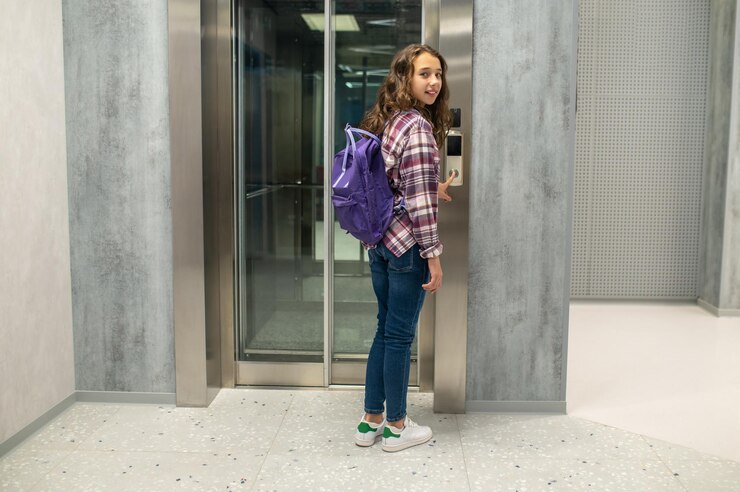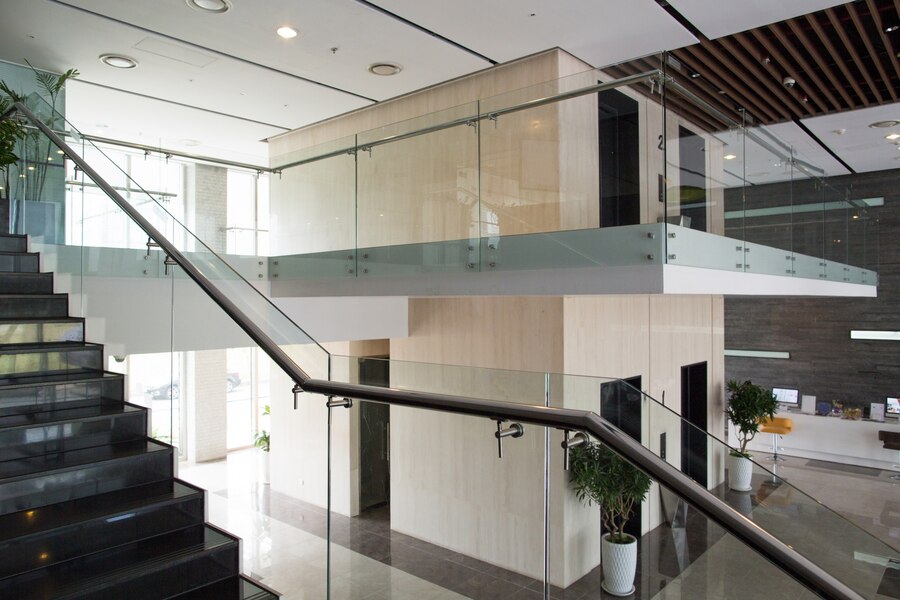
Residential elevators offer greater flexibility in size and design, but careful planning remains critical for a seamless integration into your existing space. The minimum space required for home lift in India can vary based on factors. Finding the right balance between optimal space utilization and a comfortable, efficient elevator experience is achievable. This blog post will answer your queries about the lift size requirements with effective planning.
Size Considerations for a Residential Elevator
Elevator Clearance Above the Lift
Elevator clearance refers to the minimum overhead space required for the motor and drive system. To keep this space as small as possible is crucial as it interferes with your home’s ceiling or structural elements. For conventional elevators this additional space is often 500-1000mm or more, making it difficult to install in a normal villa or apartment. Many homes also have an inclined ceiling on their topfloor making it even more difficult to fit in.
With it´s unique design SWIFT does not need any clearance at all above the lift.
Space for Electrical Cabinet
For conventional elevators the electrical components of the elevator, including the electrical cabinet, require dedicated space for installation and maintenance. Ensuring easy access to the electrical components for maintenance purposes is essential. Adequate space around the elevator’s machinery allows technicians to perform routine inspections and repairs efficiently.
SWIFT on the other hand, has all the electrical components and cabinet built into the platform with easy access for the service and maintenance staff.
Door Width
Standard residential elevator doors typically range from 36 to 48 inches (900-1200mm) in width. Wider doors facilitate easy entry and exit, providing convenience for individuals with mobility challenges or those using mobility aids. However, in a home space is often limited and more narrow doors are requested.
SWIFT offers slim doors made for home use. These doors range from 30 to 36 inches (760-900mm)
Factor Influencing Space for Lift
Customized Features
The modern era of lift technology allows for various customized features that cater to specific needs and preferences. These features, typically carrier size and door widths/heights can significantly impact the space required for lift.
Passenger Capacity
The intended passenger capacity of the lift is a critical factor that directly correlates with the size of the lift cabin. For example, a lift-rated load for 3 people should be 250 kg. Lift’s design for a single person will naturally be more minor than intended for a family of four. Consider your current needs and potential future requirements when determining the passenger capacity.

Number of Floors
The number of floors your residential elevator will service is a crucial factor influencing its size and capacity. Elevators designed for a single-floor residence differ significantly from those intended for multi-story homes.
-
Single-Floor Residences
The elevator design can be more compact in homes with just one level. Space requirements are generally minimized, making integrating the compact home lifts into the existing structure easier.
-
Multi-Story Residences
The elevator needs to accommodate increased travel distance for homes with multiple floors. The size and capacity of the elevator must be proportionate to the number of floors it will serve, considering the potential increase in passenger and load requirements.
Door Configuration
For aesthetic goals, lifts come in different door configurations, such as single-entry, double-entry, and even panoramic glass doors. Various elements influence the door configuration selection, including the building design, family situation, and the desired visual effect.
Structural Considerations
The strength of your home structure will be the starting point when the lift is being installed. Architects and engineers must evaluate load capacity and stress distribution to see if the existing structure can bear the weight and dynamic forces of the lift system. Structural modifications, like strengthening the floors and walls, may affect the space needed for the lift installation. When receiving the SWIFT lift quote, all weights and dynamic load requirements will be presented on your drawing.
Types of Residential Elevators and Specific Size Needs
Hydraulic Elevators
Hydraulic elevators are among the standard elevator types. Their popularity stems from several factors. These elevators generally have a lower initial cost than other options, making them an attractive choice for budget-conscious homeowners. These domestic lifts function like a cylinder and piston system run by a hydraulic pump. As a consequence, it occupies the machine room, located in proximity to the elevator shaft.
-
Size Considerations
Hydraulic elevators necessitate more headroom (space above the top floor) due to the piston travel. Additionally, they require a pit dug below the lowest floor level to accommodate the piston. This pit depth typically ranges from 8 inches (200 mm) with minimum overhead clearance heights of 92 inches (2300 mm).
Pneumatic Vacuum Elevators
Homing owners with space constraints find pneumatic vacuum elevators a viable alternative. These elevators employ a vacuum air pressure system to push the cabin. Unlike traditional home lifts in India, they don’t mandate a separate machine room or a shaft, making them suitable for incorporating to retrofit existing homes with compact layouts.
-
Size Considerations
Pneumatic vacuum elevators are generally the most compact option. However, they typically come with a lower weight capacity than hydraulic lifts or screw driven lifts. This might be unsuitable for large families or those frequently transporting heavy objects. Additionally, the diameter of the elevator cabin is usually smaller than other types, which might be a consideration for some users.
Screw-Driven Elevators
Screw-driven elevators are a relatively new entrant in the residential elevator market, but they’re rapidly gaining popularity due to their unique advantages. The screw mechanism is designed in such a way as to offer a soft and noise-free ride that is made possible by the incorporation of elements that bring about comfort and tranquility within the house.
-
Size Considerations
Depending on the model, screw-driven elevators require minimal or no dedicated machine room, pit or need of headroom clearance. The footprint is very space efficient and starts from 880×1365 mm.

Invest in Quality Lifts With SWIFT!
SWIFT caters to diverse needs, from compact, budget friendly options to spacious and more design oriented solutions. Our lift models comprise SWIFT Pro and SWIFT Lite, ensuring your lift design aligns perfectly with your space requirements and budget. Elevate your lifestyle or business operations with SWIFT, where we provide premium quality lifts at the best home lift prices.
Don’t settle for a cramped or noisy elevator solution. Contact us today to explore our range of lifts and discover the transformative impact of investing in excellence!
FAQs
Typically, a compact residential elevator designed for 2 persons will have dimensions starting from around 880×1365 mm.
Lift rules in India are governed by the Indian Standards (IS) codes, specifically IS 14665. Compliance with safety standards, maintenance, and periodic inspections are essential for lift regulations.
The minimum recommended lift size for accommodating a wheelchair is around 880×1465 mm., ensuring sufficient space for easy entry, exit, and maneuverability.
The lift cost for 4 floors in India can vary based on factors like model, capacity, and additional features. On average, prices can range from INR 15 lakhs to INR 30 lakhs or more, depending on specifications and customization.
Standard sizes for lifts vary, but a common size for a passenger elevator is around 6×7 feet. However, sizes can be customized based on specific requirements and building constraints.

